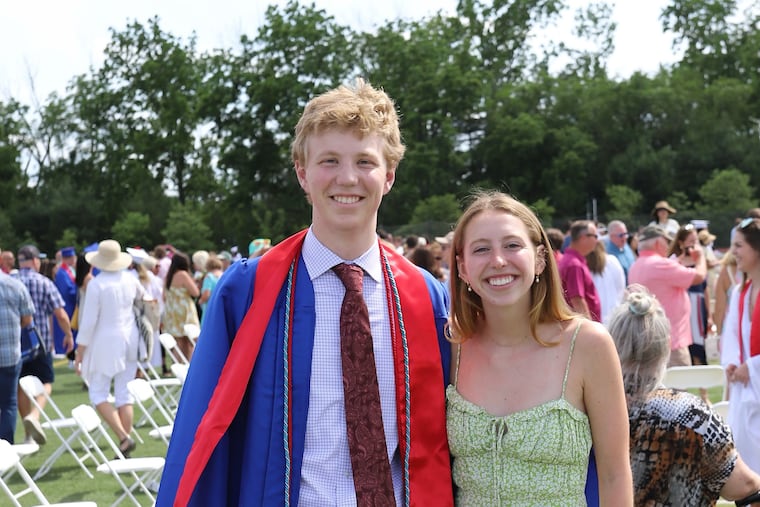A Bucks County teen’s dying wish and a $6.4 million gift to CHOP to see it through
David and Patricia Holveck gifted $6.4 million to the Children’s Hospital of Philadelphia to fund research to find better treatments for bone tumors.

When 18-year-old Connor Boyle was dying of a rare bone cancer, his parents asked his last wishes.
“I don’t want to see another kid suffer through cancer,” he replied. He died from osteosarcoma in August 2022 — the same day that the Bucks County teen was supposed to move into a freshman dorm at Villanova University, where he had been accepted into its business school.
Earlier this month, Boyle’s grandparents, David and Patricia Holveck, gifted $6.4 million to the Children’s Hospital of Philadelphia to fund research to find better treatments for pediatric patients with osteosarcoma.
“This is hopefully a first step toward making Connor’s dream happen,” his father, Matthew Boyle, said in an interview.
What is osteosarcoma?
Osteosarcoma, the most common cancerous bone tumor in children and young adults, affects about 400 children each year nationwide. It typically occurs during critical growth periods, such as puberty, and is often diagnosed after pain and swelling occurs at the bone tumor’s site.
Tumors commonly start at the femur, or long thigh bone above the knee, but can be hard to treat because each bone tumor is unique, requiring tailored treatment. Also, the disease can quickly spread to other organs or body tissues, often in the lungs. Its rarity means doctors and researchers haven’t studied it nearly as much as more common adult cancers and funding is scarce.
For this reason, treatment for osteosarcoma hasn’t changed much in the past 30 years, according to Theodore Laetsch, a pediatric oncologist who heads CHOP’s Very Rare Malignant Tumors Program. Typically, the diseased bone is surgically removed, and the patient then goes through intense chemotherapy for about six months.
About 70% of those patients are cured. But if the disease spreads, like it did in Connor Boyle’s case, only a quarter of patients will survive.
The path to a dying wish
The three-year, multimillion-dollar gift — named “The Connor Initiative: Precision Therapeutics for Osteosarcoma & Rare Cancers” — will be used to advance studies on new drug therapies and help families find their way to the best possible care experience. It will fund initiatives to:
Provide patients and their families with a nurse navigator, who will help coordinate appointments to cut down on visits to CHOP for chemotherapy, radiation and other treatments.
Capture tumor tissue from patients and study the genetic makeup of each tumor. The data will be used to determine which drugs work best against osteosarcoma and other rare pediatric cancers that share a similar genetic profile.
Study cancer cells and spearhead clinical trials that lead to new and better treatments. For instance, researchers plan to zero in on mitochondria, which generate much of the energy needed to power cells. Laetsch described mitochondria as the “powerhouse” or “energy factory” in each cell, including cancerous ones. Laetsch said they hope to cut off that power source and kill off cancerous cells.
“The endgame is to identify drugs and new therapies that can specifically attack osteosarcoma,” Laetsch said. “This is quite a lot of money and we think it will be transformative for these patients and their families.”
A determined young man
The gift will honor the legacy of Connor Boyle, who was diagnosed with osteosarcoma at age 15 at the start of his sophomore year in high school. His father remembers the exact date: Sept. 28, 2019. Connor had hit puberty. At 6 feet 5 inches tall, he played baseball, basketball and football at Central Bucks East High School.
“You’d ask him what his favorite sport was and it was always whatever season it was — that’s what his favorite sport was,” Matthew Boyle said. “He was a coach’s dream. The coach would give instruction and he would sit and listen and then do it.”
On that September morning, he felt out of breath while warming up for a football game at school.
His parents took him to Doylestown Hospital, where he was diagnosed with a collapsed lung. The condition was unrelated to cancer, but while talking to the ER doctor, Boyle’s parents mentioned a swollen bump on his right femur.
An X-ray revealed a tumor. He had never complained of any pain.
“Honestly, we just thought it was an injury from football,” his father recalled.
An ambulance crew transported him to CHOP that night. It would be the first of 102 nights he spent there over three years of treatment.
His treatment started when a surgeon removed the tumor and replaced the diseased femur with a 12-inch rod, followed by six rounds of chemotherapy, his father recalled.
Connor continued to play sports during his junior year, including on his high school’s JV baseball team. He pitched from the mound on an artificial leg.
But the disease had spread to his chest.
In all, he underwent a dozen surgeries to remove cancerous growths from his lungs and chest. He also received multiple rounds of chemotherapy, each of which required him to stay at CHOP for two days.
He didn’t want to miss school so he asked if he could do the treatment on weekends. His oncologist said he was the first patient to ever make that request, his father said.
He maintained straight A’s and got accepted into Villanova.
On his June 2022 graduation day, he woke up early and got to CHOP at about 7 a.m. for his 15th round of radiation.
It would be his last. He died about two months later.
“He just wanted to be normal. He wanted to be present,” Matthew Boyle said.